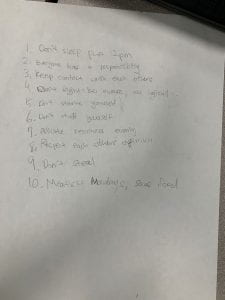In this week I learned about parabolas and how to work with them.If we have ax^2, “a” shows the stretch or the compress. If it’s negative then it’s opened down, if positive it’s opening up. X^2 + p means the y intercept is at “p”. If we have (x – q)^2, the value of q shows the horizontal translation. If it’s negative then it means the parabola goes left, if positive it goes right.
Author Archives: amiryazdanb2016
Week 7 in Pre-Calculus 11
In this week I learned how yo solve a quadratic equation with the quadratic formula. The formula is written on the picture attached to this post.
a= coefficient of x squared
b= coefficient of x
c = the integer
You just have to replace the a, b, and c with numbers and then you just have to calculate.
Red Team Laws
Week 6 in Pre-Calculus
In this week I learned how to solve a quadratic equation. A quadratic equation is a equation which the variable in it has a power of 2 or more. In order to solve it, we first have to make one side of the equation’s to zero. For ex. (x+5)(x-7)=0
Now we have a equation, which in it the, the multiplication of two brackets evens to zero. That means one the brackets worths zero. Either x+5=0 or x-7=0. we have to solve these to new equations.
x+5=0 ==> x=-5
x-7=0 ==> x=7
both of these answers are correct and it can be any of them.
Week 5 in Pre-Calculus
In this week I learned how to work with slope and graph. I learned when we have Y=3x +4,
The 3x is actually 3/1x. The Nominator is the amount of the units you go up and the denominator is the amount of the units you go right. The 4 is the Y-intercept which means it’s the number you start with. So when you have Y=3/1x + 4, the first point is 4 on the Y axis, (0,4). then you go 3 units up and 1 unit right. that’s the second point. you keep doing that until you have enough points to draw the line.
Week 4 in Pre-Calculus
In this week i learned that if you have a radical in as your denominator, you should turn your denominator to a rational number. in order to do that, you have to multiply your nominator and your denominator with the same number that’s is in your nominator. and if in your denominator you have a radical + a number you have to multiply it with it’s conjunction which is radical – number.
you have a radical + a number you have to multiply it with it’s conjunction which is radical – number.
Week 3 in pre-calculus 11
In this week I learned how to turn a normal radical into a mix radical when there is a variable in it.
so if he have it works like any other mix radical and it will become 5
we cant take x out because the exponent of x must be greater than 1. now we have the mix radical, but the key point is that we cant have a negative number under the square root sign so we have to come up with a restriction: x has to be greater or equal to zero.
Learning LateX coding
Week 2 in Pre-Calculus 11
In this week i learned how to work with powers with positive rational exponents.
Week 1 in Pre-Calc
Terminology!
In this week, I learned a lot of Important and useful terms in Pre-calculus 11. I knew the terms in Farsi but now I know them in English! Here’s the list of them:
Squared root, Integers, Whole numbers, Rational numbers, Irrational numbers.


